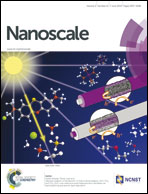NaYF4:Yb,Tm nanocrystals and TiO2 inverse opal composite films: a novel device for upconversion enhancement and solid-based sensing of avidin
Abstract
Upconversion luminescence (UCL) detection based on rare-earth doped upconversion nanocrystals (UCNCs) as probes has been proved to exhibit a large anti-Stokes shift, no autofluorescence from biological samples, and no photobleaching. However, it is still a challenge to achieve a stable, reproducible solid-based UCL biosensor because of ineffective UCL of the UCNCs. In this work, we fabricated TiO2 inverse opal photonic crystals (IOPCs)/NaYF4:Yb3+,Tm3+ (Er3+) UCNC composite films, which can tremendously improve the overall UCL of Tm3+ as high as 43-fold. Based on the fluorescence resonance energy transfer (FRET) and the specific interaction between biotin and avidin, a novel solid-based UC biosensor is presented for sensing avidin. This solid-based detection system is convenient for detection, and also can offer two parameters for detecting trace amounts of avidin, namely, the emission intensity and the fluorescence decay time. The sensor has a high sensitivity of 34 pmol−1, a good linear relationship of 0.996 and a low detection limit of 48 pmol. It also exhibits excellent long-time photostability, and the absence of autofluorescence, and thus may have great potential for versatile applications in biodetection.


 Please wait while we load your content...
Please wait while we load your content...